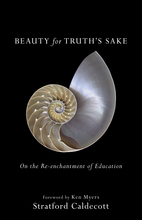“Music, architecture, astronomy, and physics — the physical arts and their applications — demonstrate the fundamental intuition behind the Liberal Arts tradition of education, which is that the world is an ordered whole, a ‘cosmos,’ whose beauty becomes more apparent the more carefully and deeply we study it. By preparing ourselves in this way to contemplate the higher mysteries of philosophy and theology, we become more alive, more fully human. This beautiful order can be studied at every level and in every context….” STRATFORD CALDECOTT (pp. 116-117)

Beauty for Truth’s Sake: On the Re-enchantment of Education
Stratford Caldecott (1954-2014)
Grand Rapids, MI: Brazos Press, 2009, 2017 ed.
156 pages
ISBN: 978-1-58743-402-0
Whereas many Christian educators stress a return to the trivium (grammar, rhetoric and dialectic) as foundational disciplines, the quadrivium (arithmetic, geometry, astronomy, music) do not always get as much attention. But in this lovely book, Stratford Caldecott makes the case that the quadrivium (i.e., “the four ways”) are every bit as important for a Christian liberal-arts education as the literate arts of the trivium. The four disciplines of the quadrivium are all concerned with numbers: “arithmetic being pure number, geometry number in space, music number in time, and astronomy number in both space and time” (p.24). All seven ways were originally understood as necessary preparation for a Christians to begin thinking theologically. In the Christian tradition, the purpose of education was “to teach the ability to think, discriminate, speak, and write, and, along with this, the ability to perceive the inner, connecting principles, the intrinsic relations, the logoi, of creation, which the ancient Christian Pythagorean tradition . . . understood in terms of number and cosmic harmony” (p. 28). The bulk of the book is spent on a survey of each of the numerate arts, considering the ways in which each reveals the beauty of the cosmos and reflects the glory of God.
Numbers are not my natural language, but I found this book to be compelling, and my copy is now heavily annotated. I was especially struck by the disciplinary breadth of Caldecott’s reading. He pulls together an impressive array of sources in this brief book: mathematicians, scientists, philosophers, and theologians from Catholic, Orthodox, even Muslim and Hindu backgrounds. He’s not terribly interested in Protestants, but nonetheless his bibliography will interest anyone who wishes to think more deeply about beauty and faith.